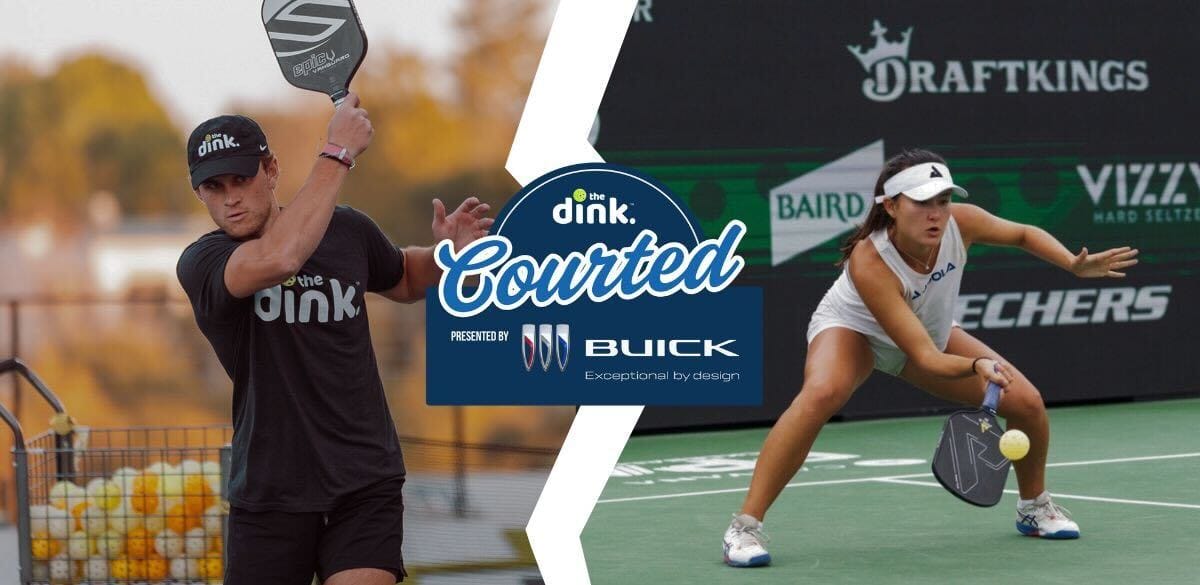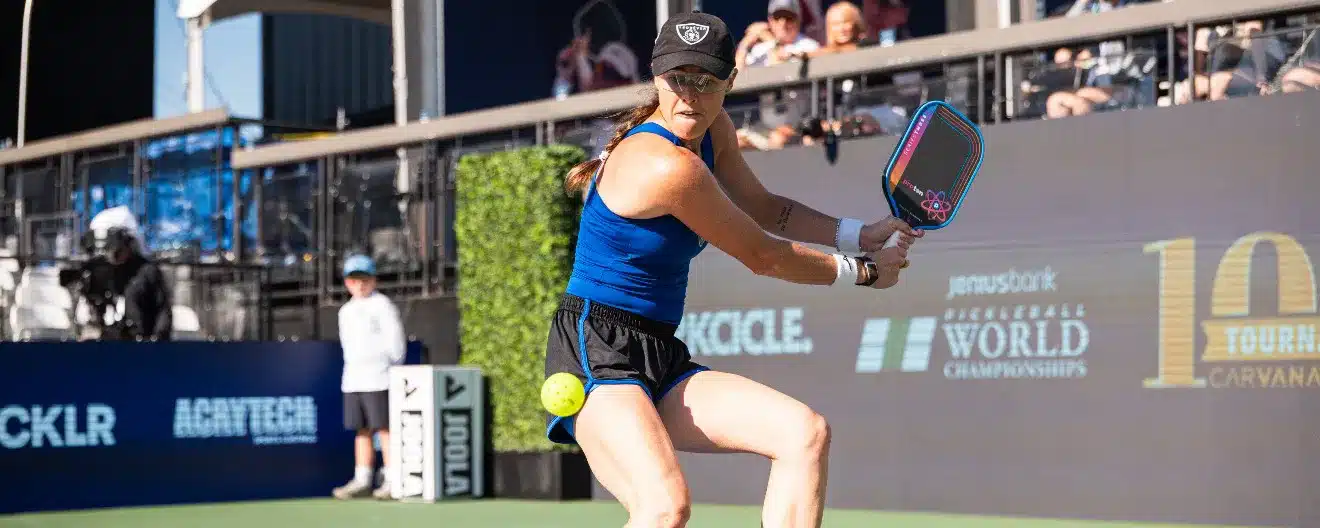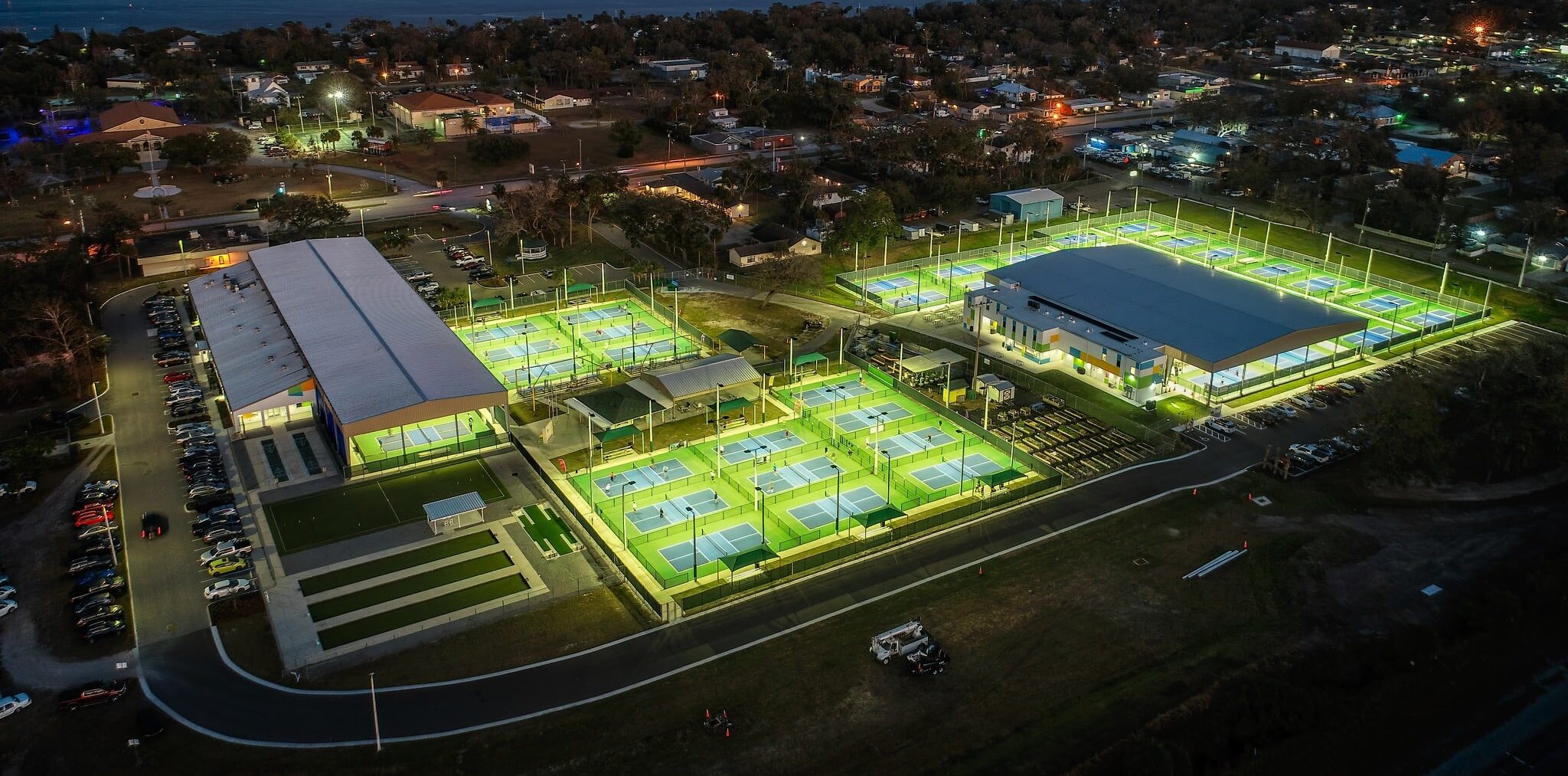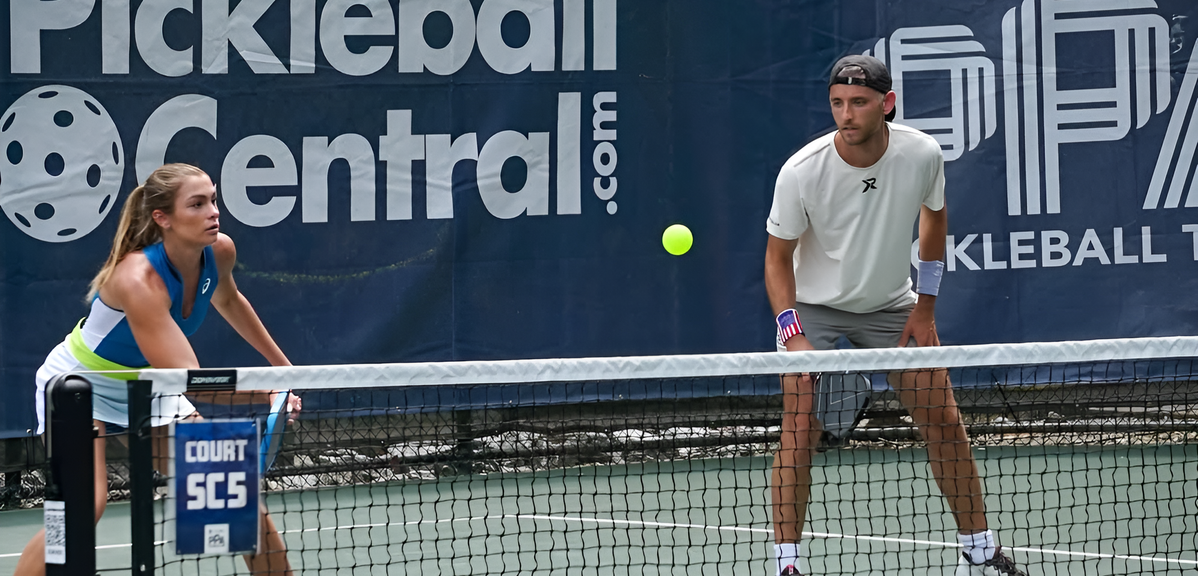Pickleball - the sport that once dominated retirement communities is now striking chords with all age groups, including kids and teens. The only surprise in this news is that it took as long as it did. You always knew that once they played their first game they'd be hooked, just like you were. While the younger generations are entering the sport in greater numbers than ever before, it's never been the easiest thing to convince a child or grandchild to try something new. Especially with the added challenge of helping them see past the age stereotype and appreciate pickleball for the fun, family-oriented sport that it is.
Nevertheless, it's a challenge worth undertaking. Introducing your kids and grandkids to pickleball is about more than just helping them find a new hobby. It's about strengthening bonds, promoting an active lifestyle, and fostering a love for a sport that embraces inclusivity.
This is where we come in; we've built this guide to support you in your pickleball evangelism. In the coming sections, we're going to get down and dirty with pickleball's appeal at any age. We'll share tips on how to make the game fun and exciting for everyone and throw in some stories from families who have successfully turned pickleball into a family tradition. With this guide, you'll be well on your way to turning the dreaded family reunions into epic pickleball showdowns.
Step-by-Step Guide to Teaching Pickleball
Teaching a 10-year-old how to play pickleball requires a far different approach than teaching a 17-year-old the sport. So where do you begin? Well, like writing a story, first set the scene. Or in our case, stage the pickleball court by establishing some of the rules. Don't go overboard here - they don't need to know all 500 rules in the book. Just the basics to make it semi-challenging but completely fun.
1. The Setting: Rules and Keeping Score
First things first, let's demystify the rules and scoring of pickleball. Even before you get to the courts, you'll want to prep their minds for it by mentioning how pickleball is a simplified version of tennis and table tennis - a refreshing blend of simplicity and strategic nuance. In teenager-speak, "Pickleball is like the lovable cousin of tennis and ping-pong, embracing all with its easy rules and inclusivity."
Then hit them with the basics, such as:
- Format: The game can be played in singles or doubles format - doubles is the most popular.
- Scoring: Points are scored only by the serving side, and each player on the serving side gets a shot at serving before the serve goes to the opposing side.
- Winning Points: Games are typically played up to 11, but you need to win by a margin of two points.
- Two-Bounce Rule: A unique rule, known as the "two-bounce rule", requires that the ball must bounce once on each side before volleys (hitting the ball before it bounces) are allowed (not to be confused with the double bounce as they may assume).
- Kitchen: Show them where the kitchen is and explain that they can go in there any time they want, but they cannot volley from in the kitchen - remember, the kitchen includes the kitchen line.
On the last one there, the kitchen, don't feel like you need to rush into explaining that part in the first game. Let them get used to hitting and just keeping track of the other components above. Once they've got the basics, then let them know about the no volleying in the kitchen, but that they can still be in the kitchen whenever.
As you know, there are far more rules to playing pickleball and many more nuances to keeping score, but there's no need to get at that on day one. Remember, the goal of the rules and keeping score early on with kids and grandkids is simply to make it a challenge for them, not to make it impossible or dull. You can add more of the rules as they get more into the sport.
2. Basic Shots: Serving, Volleying, Dinking
Now, let's tackle some basic shots that are key in pickleball: serving, volleying, and dinking. You could have a field day with each topic, but we'll hit the most foundational components of each, giving you an idea of what you should share to get a kid started in pickleball.
- Serving: Depending on the age, you may want to just have your child focus on landing a shot in the diagonal service area, avoiding the kitchen. But if you think the child has enough arm to get the ball into the service area underhand, then go ahead and let them know the rules of serving - they could go volley serve or underhand, where the latter is contact below the waist.
- Volleying: Volleying requires swift reflexes, to hit the ball mid-air without letting it bounce. Talking through volleys is usually a good time to explain the kitchen rules.
- Dinking: This one usually gets some chuckles from the kids - let them know it's a funny name, but also one of the most important shots in the game - it involves softly hitting the ball just over the net into the non-volley zone or "kitchen". That's because pickleball is as much a game of finesse and soft shots as it is about power, if not more so.
When you think they've got these down, you can introduce them to more detailed versions of each or share some new pickleball shots with them. For more resources, we've included links to more comprehensive content for each shot above.
3. Gear: What Do You Actually Need?
If you don't have any spare paddles or an open court lying around... you might not be sure what to do. Not to worry this sport doesn't require a mountain of gear. What you do need is a paddle, a pickleball (yes, the ball and namesake), and a pickleball net for a makeshift court. Remember, this isn't the last day of the US Open, you're just trying to create a fun environment for the family to enjoy their time together. We're certainly qualified to help you on the paddle front. And we have a semi-controversial opinion on paddles for kids.
Kid-Friendly Equipment
If you've seen pickleball paddles that are scaled down for kids (think ping-pong size) you should know that these are quite frustrating for kids to play with. Young kids in particular don't have the coordination and body awareness to hit the ball every time it heads their way... so the cruelest thing you can do is make their paddle smaller while keeping the court the same size.
Instead of finding a tiny-human scaled paddle, instead, think about getting a regular paddle for them that compensates for their size. Maybe that's getting an elongated paddle to give them extra reach, getting a lighter paddle to make it easier to swing, going with a paddle that gives them additional power to make sure the ball clears the net - or just getting something that is nice and balanced all the way across.
The point is, don't buy the hype that the paddle should be scaled down. Simply get a lighter paddle with a smaller grip for them to be able to hold it. Then consider ways to get paddles that help them where they need it most.
For the pickleball itself, opt for outdoor balls. These are slightly harder and easier to control, reducing the chances of unpredictable flights. A net with adjustable height can be advantageous, making the game more accessible for the younger ones. Think of these as your magic ingredients for a family-friendly pickleball experience. Beyond these elements, buy some tape to mark off the lines for your playing surface, if you're unable to get to a proper court. And that's all you'll need to make a memorable family day with pickleball.
Creating a Pickleball-Friendly Environment
The cornerstone of a pickleball-friendly environment is undoubtedly a positive and supportive attitude. Like sunshine to a blossoming flower, an encouraging vibe can work wonders for young learners. Celebrate their tiny victories, whether it's a successful serve or a well-executed volley. Remember, their joy in playing pickleball is directly proportional to the enthusiasm they see in you.
Let positivity be your family's pickleball motto, transforming the court into a playground of smiles high fives, and happy squeals!
Keeping the Game Fun and Pressure-Free
The secret ingredient to a great pickleball experience? Keeping the game fun and pressure-free. Perhaps this goes without saying, but the moment the game becomes super competitive with young kids is the moment you start teaching young kids that making mistakes is unacceptable.
Instead, introduce creative games, like who can maintain the longest volley rally (more small game ideas in a minute). Think of pickleball as an enjoyable board game, where the focus is on laughter and camaraderie rather than the scoreline. After all, the biggest win here is the fun shared, and not the points scored. Nobody is going to remember every score of every game in the driveway, but they will hopefully remember how they felt playing together in the driveway. And you want that to be a fond memory.
Tailor the Game to Them
Just as we adjust the seat height when teaching kids to ride a bike, pickleball can also be customized to their skill level. One way to do this is by lowering the net, which can turn seemingly unreachable shots into exciting victories for the young ones.
Additionally, you can reduce the court size, think skinny singles vs. singles, where you create an environment more conducive to dinking by shrinking the court. This is particularly helpful if your crew is having trouble getting to the ball quick enough. By tailoring the game, we transform the pickleball court into a fun, stress-free zone where kids can learn at their own pace and savor each rally. Don't be afraid to adjust wherever is needed to ensure a good time by all.
- Making the Game Fun - Integrating Games and Challenges: Pickleball can easily be the backdrop for a host of exhilarating games and challenges. Why not turn a volleying session into a quest for the 'longest rally'? Or perhaps, invent a game where the goal is to 'dink' the ball into a specific zone? By integrating these fun elements, pickleball practice becomes less about strict rules and more about creativity and amusement. So let the games begin, and watch as pickleball becomes the star of your family's game night!
- Encouraging Friendly Competition - Arranging Family Tournaments: Lastly, a dash of friendly competition can add a spark to pickleball practice. Organize a mini family tournament, complete with fun team names and playful trophies for winners. Remember, the aim is not to ignite fierce rivalry but to foster teamwork, perseverance, and sportsmanship. These family tournaments can be your exclusive family carnival, where the cheer of 'match point' is less about winning and more about the collective enjoyment of pickleball.
Become the Guide At Their Side
We love the expression of teaching by being a "guide at your side" rather than a "sage on a stage." And this couldn't be more impactful than in teaching moments with children. Your role as a mentor is crucial. When they're interested in improving on something, don't use that as a time to show off how good you are at it. Instead, be the guide at their side and work through the mechanics of whatever challenges they face. If they're struggling to master a concept, break it into smaller pieces. While you may not think of this as the first stop on the feedback train, it should be. Feedback was never meant to be criticism, in fact, feedback is best as a demonstration rather than a verbal critique, although it can take either form.
Your feedback though should be a stepping stone for improvement, if they want it. If they just want to swing a paddle, embrace that and swing one with them. The difference between the two is hitting the batting cages for a baseball tournament vs. playing catch in the backyard and chatting it up. One is competitive, the other is cathartic. It's important to read their intent and be supportive in either scenario.
Even if they're focused on getting better and competing, encouragement isn't always about celebration, it also includes helpful advice. What does this look like then? Celebrate their successful dinks and volleys, but also remind them that it's okay to miss a serve. Constructive feedback is like adding sprinkles to a sundae, it makes the whole experience better. Keep your encouragement consistent and positive, reminding them that the journey of learning pickleball is as rewarding as the game itself.
Progress by Gamifying Practice
As with any sport, practice makes perfect in pickleball. If your kids have the pickleball bug and want to get better, but can't always play around the clock, doing drills will go a long way. Consider setting up regular drills that focus on serving, volleying, and dinking - just don't call them that.
Pickleball can easily be the backdrop for a host of exhilarating games and challenges. By integrating fun elements, pickleball practice becomes less about strict rules and more about creativity and amusement. For example:
- Serving: Set a target a distance away and see who can underhand hit it in the target 10 times in a row.
- Volleying: Create a fun volleying game where the aim is to maintain a volley rally for as long as possible.
- Dinking: Invent a game where the goal is to 'dink' the ball into a specific zone or a bucket, and see who can get it to land in the zone or stick in the bucket first.
Encouraging Practice: Setting Up a Home Pickleball Court
Think of pickleball practice as a fun family ritual. Regular practice at home will not only sharpen their skills but also fuel their love for the game if they have the spark. To make this easier, consider setting up a home pickleball court. It doesn't have to be fancy; it just needs to be in a safe location on a smooth, flat surface with marked boundaries.
Whatever you do, don't make practicing a requirement, and don't make it anything less than entertaining. If it feels like boot camp, they'll tune you out quickly. Which is a perfect segue into the next section.
Involving Kids in the Pickleball Community
Let's not forget the vibrant pickleball community that exists beyond your cul-de-sac - it's brimming with potential for any person at any age. After all, the greater pickleball community is largely responsible for the sport's exponential growth. Tap into that and show them what having fun, socializing, and competition can look like. We're sure that many adult players would have loved to play at a young age.
Involve the kids in local pickleball events, be it friendly matches, tournaments, or skill-based workshops. This will help them learn from other players and make new friends, enriching their overall experience.
- Tournaments: As your family's skills grow, why not consider participating in local tournaments? With tournaments popping up every day, you'll have options to pick from regardless of where you live. It adds an exciting dimension to the game and could even open doors to larger events. Plus, many communities host charity matches - a great way to have fun while giving back.
- Clubs and Leagues: Regular play is key to improvement, so you could even consider joining local pickleball clubs or community groups. Many towns have clubs that welcome all age groups, providing an excellent opportunity for regular practice and fostering a sense of belonging. It's a beautiful sight to see children, parents, and grandparents all gearing up for their weekly pickleball rendezvous.
- Friends: And of course, one of the best ways to foster a love for pickleball is to encourage kids to play with their friends. A shared activity can create camaraderie, and pickleball matches can be the perfect setting for friendly banter and shared high-fives. Plus, it gives children a chance to introduce others to this wonderful game, potentially sparking a ripple effect of pickleball enthusiasts.
When you look at pickleball from this lens, it becomes an exciting field trip that opens doors to a lively, energetic community. The perfect place for your kids and grandkids to learn.
Pickleball Is Packed with Benefits
Pickleball can be more than an entertaining game - it can serve as a gateway to a fulfilling aspect of a person's life. The advantages are multi-faceted, covering physical, social, cognitive, and emotional spaces. In all, the benefits yield a sport that acts as a bonding tool for developing important habits and life skills. Check these out:
Physical Benefits: Coordination, Mobility, Cardio
Pickleball, with its swift volleys and speedy footwork, is an excellent sport to improve hand-eye coordination and mobility in children. As they predict the flight of the ball and position themselves accordingly, kids refine their agility and dexterity.
Plus, regular games of pickleball make for a fun cardio workout, helping to maintain a healthy heart. Think of it as a lively health-boosting activity that kids would love to engage in, instead of routine exercise.
Social Benefits: Teamwork, Communication, Friendship
The beauty of pickleball lies in its ability to foster social skills. As a team sport, it encourages children to communicate effectively, strategize together, and celebrate their wins as one. And its also earned the unofficial distinction as the most social sport on the planet.
It’s not just about scoring points, but also about learning to rely on and support their team members. Plus, sharing an interest and experience is how some of the strongest friendships are born; pickleball could just become the bridge that connects your child to lifelong companions.
Cognitive Benefits: Strategy, Focus, Decision-Making
Pickleball isn't merely a physical game; it's a cerebral one too. It's the soft-handed tactician that gets the trophy - not the overly aggressive banger. It's a game of constant strategy and mental maneuvering, deciding where to place the ball or when to opt for a deep drive versus a dying 'dink.' This demand for quick decision-making and focus can help sharpen your child's cognitive abilities. It's like chess with exercise.
Emotional Benefits: Confidence, Stress-Relief, Joy
Finally, pickleball serves as a wonderful platform for building self-confidence. As children witness their skills improve over time, they gain a sense of accomplishment that strengthens their self-esteem. It provides a healthy outlet for stress, replacing school or life worries with the simple joy of playing and moving around, rather than sitting in front of a screen for hours on end.
From the physical perks like improved coordination to the emotional gains like boosted confidence, it's a game that truly serves all ages. The universality of pickleball is its true charm - a sport that a 7-year-old can enjoy just as much as a 70-year-old. Again, pickleball has the potential to be more than a sport, especially for young kids. With the right guide at their side, kids can have one of the most enriching experiences available. Who'd have thought a little plastic neon ball with holes in it would paint more vibrant colors of confidence, relief, and greater wellness?
Share the Love with Your Little Loved Ones
If you know anything about pickleball, you know the sport's origin is rooted in two families on vacation that created a game in the backyard to keep everyone entertained. In many ways, pickleball was made for kids first and foremost. But just like learning any sport, pickleball requires patience and perseverance.
Children might miss a few shots at first, and that's great. This is your cue to remind them that mistakes are all part of the journey to master the game. A lesson that they'll appreciate even more with time. When you approach the faults in this manner, it will make celebrating even the smallest wins that much sweeter - it could be their first successful serve or a skillfully returned volley. With time, they'll be making those winning shots effortlessly, their initial stumbles now badges of their dedication, serving as a reminder that patience and perseverance pay off.
Above all, pickleball is about family. The memories made, the friendly rivalries, the shared victories - it all weaves a rich tapestry of family bonding. There's nothing quite like the joy of rallying with your loved ones, the anticipation of the next serve, and the collective cheer when a point is scored. Here's to pickleball - not just a game, but a portal to treasured family moments.
Anuncie Aqui / Advertise Here
Sua marca para o mundo Pickleball! / Your brand for the Pickleball world!

 English
English  Spanish
Spanish  Portuguese
Portuguese  German
German  Italian
Italian  Japanese
Japanese  French
French  Polish
Polish  Russian
Russian  Netherlands
Netherlands  Hungarian
Hungarian  Turkish
Turkish  Videos
Videos 








 English (US) ·
English (US) ·  Portuguese (BR) ·
Portuguese (BR) ·